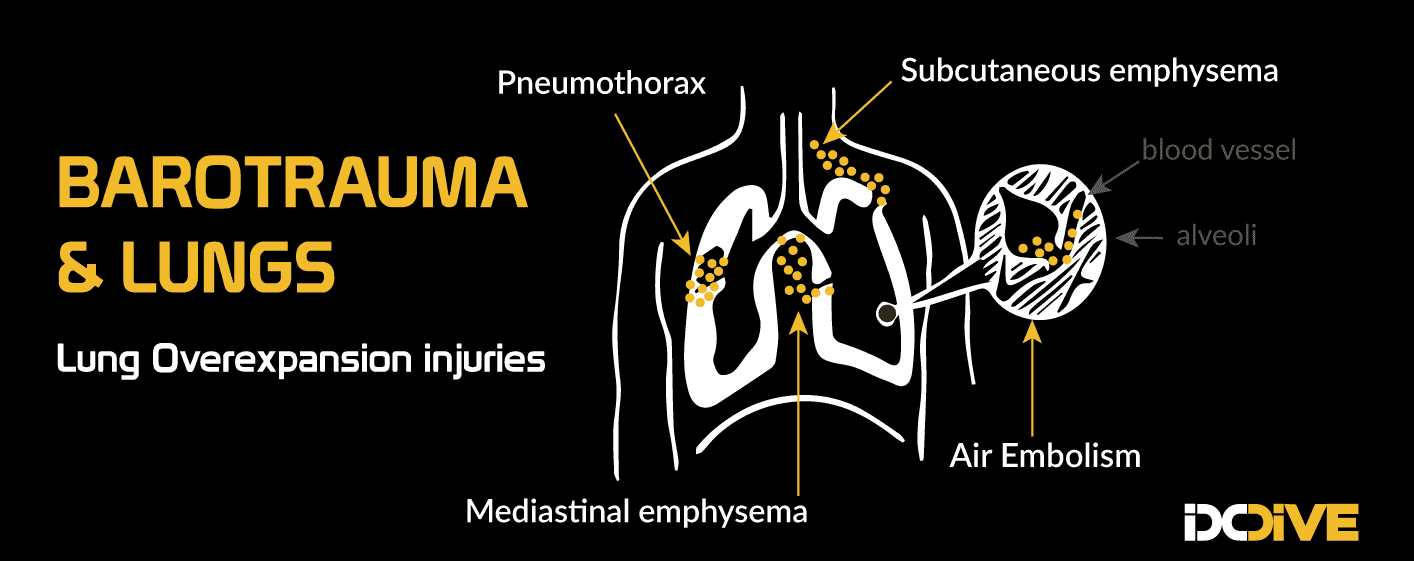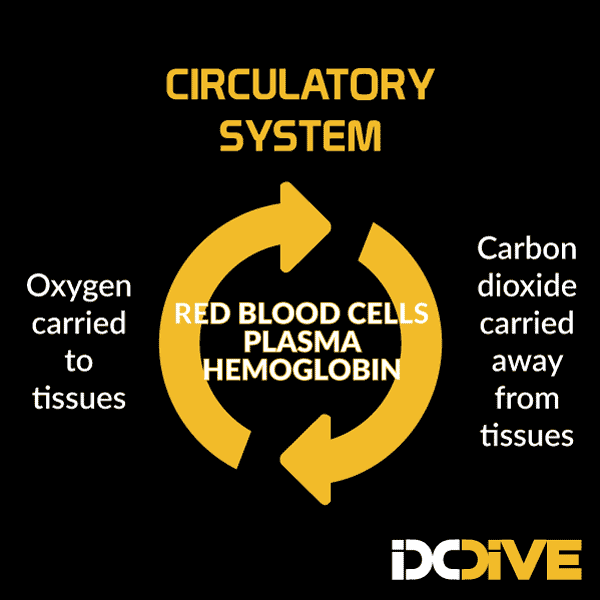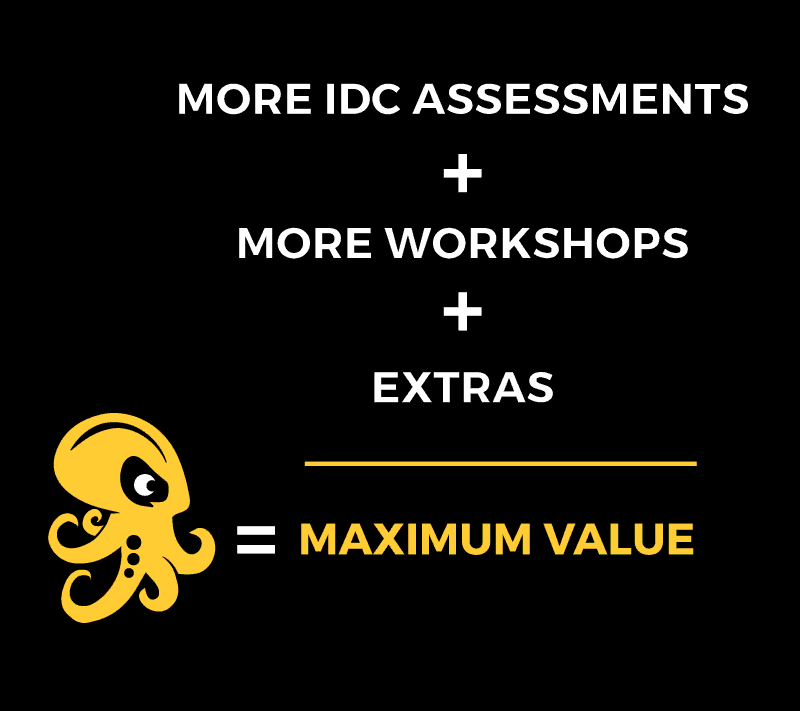Dive Theory Physiology
DOM GIBBINGS

Dive Theory: Physiology
Once you have followed our study guidelines, use these Revision guides to help you memorise the required knowledge for your IDC & IE dive theory exams.
Circulatory & Respiratory Systems
Their purpose is to supply tissues with oxygen and remove and eliminate CO2.
OXIDATIVE METABOLISM = process of turning chemical energy into usable energy.
Gas exchange between circulatory and respiratory system occurs between the capillaries and the alveoli.
Circulatory System
HEART = a four chamber pump that circulates blood
ARTERIES = carry oxygenated light red blood away from the heart
VEINS = carry dark red (low O2) blood toward heart
CAPILLARIES = microscopic vessels. Where gas exchange occurs
Respiratory System
LAW OF GASEOUS DIFFUSION: a gas always moves from an area of high pressure to an area of lower pressure until the pressure is equal.
TIDAL VOLUME = volume of gas you inhale and exhale in a normal breath.
VITAL CAPACITY = maximum volume that you can inhale after total expiration.
RESIDUAL VOLUME = the air left in your lungs after you exhale completely.
Responses to Diving
Responses Underwater
Dead Air Space increases = snorkel and regulator Tidal volume in the water = reduced 15-20% Shallow breathing = CO2 level increases, breathing rate increases.
How to avoid problems? by deep normal breathing.
DEAD AIR SPACE = Portion of your tidal volume that plays not direct part in gas exchange.
Apnea (breath-hold diving)
During apnea, the body uses oxygen stored in the lungs, muscles and blood.
Accumulating CO2 creates the urge to breathe.
BRADYCARDIA: Slower heart rate than normal due to immersion.
Circulatory & Respiratory Systems: Problems Diving
Carotid Sinus Reflex
Slowing of the heart caused by constriction of the carotid arteries.
Symptoms: discomfort and lightheadedness, eventually leads to unconsciousness.
How to avoid it: Not wearing a tight wetsuit, hood or drysuit neck-seal.
Hypercapnia (Excessive CO2)
Causes: overexertion, dead air space, rapid shallow breathing, skip breathing.
Symptoms: headache, confusion, feeling of air starvation.
How to avoid it: breathe deeply and reduce activity at the first symptoms of overexertion.
Hypocapnia (Insufficient CO2)
Causes: hyperventilation.
Symptoms: dizziness, light-headedness, fainting.
How to avoid it: don’t hyperventilate before a breath-hold dive.
Carbon Monoxide Poisoning
Carbon Monoxide (CO) is hazardous because it bonds with hemoglobin, more readily that O2, thereby interfering with oxygen transport.
Symptoms: headache, confusion, narrowed vision and with more exposure unconsciousness.
How to avoid it: Fill your tanks only from reputable fill stations!
Oxygen Toxicity
CENTRAL NERVOUS SYSTEM (CNS)
Cause: Exposure to PO2 greater than 1.4 ata
Symptoms [VENTID] : visual disturbances (tunnel vision, blurring) ear disturbances (ringring, music), nausea, twitching (especially in the face), irritability, dizziness (vertigo)
Hyperoxic seizure = convulsion. Underwater there is the risk of drowning
How to avoid it: Don’t exceed and PO2 of 1.4 bar/ata
PULMONARY TOXICITY
Cause: Lengthy exposure to elevated PO2 greater than 0.5 bar/ata
Symptoms: mild throat irritation, cough, lung irritation, burning in the chest, decrease of the vital capacity and reduction of the lungs’ ability to exhale gas.
How to avoid it: follow the oxygen exposure limits on the DSAT Oxygen Exposure Table
The body appears to recover (10-36h) when return to normoxic (normal oxygen 0.21 bar/ata) conditions.
Gas Narcosis
Causes: toxicity of inert as under high pressure (Nitrogen)
Symptoms: euphoria, bad judgment, slow motor skills.
Contributing Factors: individual susceptibility; drugs and alcohol; poor conditions (limited visibility, cool water) stress, etc.
Avoid by:
- Limit depth to <30m
- Training and Experience
- Add Helium to breathing gas
Problems in Body Air Spaces
Barotrauma
BAROTRAUMA= pressure injury. Results when a body air space is not equalised with the ambient pressure.
SQUEEZE = Ambient pressure is more than body air space (descending).
REVERSE BLOCK (REVERSE SQUEEZE) = Expanding air from body air space cannot escape during ascent.
How to Avoid: If pain is felt in ears, sinuses or teeth during ascent, descend slightly, stop, wait, then ascend slowly.
Lung Overexpansion injury is a type of Reserve Squeeze cause by holding breath on ascent.
Types of Barotrauma
EAR = Middle Ear Squeeze; Eardrum Rupture; Reverse block; Round Window Rupture
LUNGS = Lung Thoracic Squeeze; Overexpansion Injuries: Air Embolism (AGE), Pneumothorax, Mediastinal Emphysema, Subcutaneous Emphysema
SINUSES
MASK
The Ear

The Middle Ear is the area most affected by changes in pressure.
Middle Ear Squeeze
Causes: failure to equalize or inability to equalize due to congestion (with a cold).
Process: Eardrum flexes inward from pressure. Hydrostatic pressure forces blood and fluid into middle ear until equilibrium is restored.
Symptoms: sharp pain, reduced hearing
How to avoid it: by equalizing, and stopping descent if unable to equalize.
Eardrum Rupture
Causes: failure to equalize, but pressure increases faster than fluids can fill the middle ear. Eardrum tears due to pressure.
Symptoms: momentary sharp pain, then relief. Risk of infection and permanent damage.
How to avoid it: equalizing, and stopping descent if unable.
VERTIGO = cold water in the vestibular canals.
Reverse Block (or Reverse Squeeze)
Cause: diving with a cold or using decongestants
Process: A blockage, such as mucus in the eustachian tube, stops excess pressure escaping a body air space during an ascent.
How to avoid it: Do not dive with a cold!
If you feel pressure building in ears, sinuses or even teeth fillings, stop or slow ascent and wait for trapped air to dissipate.
Round Window Rupture
Cause: delayed equalization accompanied by forceful Valsalva equalization (exhaling against pinched nostrils).
Symptoms: balance problems, can cause permanent deafness
How to avoid it: Equalize early, often and gently.
The Lungs

Lung (Thoracic) squeeze
Causes: breath-hold dive to a depth where the lung volume is reduced below the residual volume can cause a lung squeeze.
Symptoms: fluid accumulate in the lungs
Lung over-expansion injuries
Causes: expanding air over-expands in the lungs causing lung rupture.
Types (in order of severity): Air Embolism (AGE), Pneumothorax, Mediastinal Emphysema, Subcutaneous Emphysema.
First Aids:
- Administer Oxygen: accelerates N2 elimination raises O2 levels maximizing the effectiveness of the blood
- Unconscious Breathing Patient: Lie level the left side, head supported
- Non breathing Patient: ABCABs
Air Embolism (AGE)
Cause: air enters the bloodstream.
Bubbles can lodge anywhere, but most common is to via the carotid arteries cause cerebral air embolism.
Treatment: prompt re-compression.
Pneumothorax
Cause: air accumulates between lung and chest wall, causing lung collapse
Symptoms: chest pain, cough up blood
Treatment: may require surgical removal of air.
Mediastinal Emphysema
Cause: air accumulates in center of chest over heart
Symptoms: feel faint and/or short of breath
Treatment: will dissipate on its own.
Subcutaneous
Emphysema
Cause: air accumulates in soft tissues at base of neck.
Symptoms: feels fullness in neck and voice may change. The skin may crackle to the touch.
Treatment: will dissipate on its own.
Other Barotrauma
Sinus Barotrauma
Sinuses = spaces in the head connected to the nose. The sinuses filter and moisturize the air before it reaches lungs.
Cause: diving with a cold
Symptoms: sinuses fill with blood and fluid during dive – sharp pain against eyes. Diver surfaces with blood in mask.
How to avoid it: do not dive with a cold!
Mask Squeeze
Causes: very rapid descends. When a diver neglects to equalize the mask air space by exhaling through the nose.
Symptoms: swelling damages capillaries, bruising the skin around the eyes and the cheeks, red eyes. Looks dramatic but clears without complication
How to avoid it: equalise the dead air space of the mask
Nitrogen Absorption and Elimination
How the body responds to Nitrogen?
Gases dissolve into liquids proportionately to the pressure exerted.
While diving, nitrogen goes into solution in body tissues. Different tissues absorb and release nitrogen at different rates. Recreational dives are too short to reach saturation.
Upon ascent, higher nitrogen pressure in tissues results in nitrogen dissolving out of the body. If pressure gradient is within limits, elimination is harmless.
Silent Bubbles
Some excess nitrogen collects in microscopic pockets in the blood vessels forming tiny bubbles. Tiny bubbles come together to form larger, but still harmless silent bubbles.
Silent bubbles are detectable by Doppler ultrasound flow meters.
Problems
DECOMPRESSION SICKNESS (DCS) = Refers specifically to conditions caused by nitrogen coming out of solution in the body.
Symptoms depend on amount and location of bubble formation.
DECOMPRESSION ILLNESS (DCI) = Refers to both decompression sickness and lung over-expansion injuries.
Same Emergency Procedure for all DCI
Decompression Sickness (DCS)
DCS – The Bends
PREDISPOSING FACTORS:
Excess CO2, Dehydration, Injuries/illness, Alcohol, Cold water, Heavy exercise, Altitude / flying, Body Fat, Age
DCS FIRST AIDS
Administer Oxygen: accelerates N2 elimination raises O2 levels maximizing the effectiveness of the blood
Unconscious Breathing Patient: Lie level the left side, head supported
Non breathing Patient: ABCABs,
DCS TREATMENT
- re-compression
- slow decompression
- oxygen administration
DCS TYPE I
(Pain Only)
CUTANEOUS DCS = skin bends
Not immediate life threatening. Res rashes, patches on the skin.
LIMB AND JOIN PAIN = pain only
Not immediate life threatening. tingling, numbness.
DCS TYPE II
NEUROLOGICAL DCS
Symptoms: numbness, touch, paralysis, fail of life support functions, unconsciousness, death.
PULMONARY DCS “The Chokes”
Symptoms: circulatory system failure, breathing pain, air-starved, shock, unconsciousness, death.
CEREBRAL DCS
Symptoms: [=AGE] blurred vision, headache, confusion, unconsciousness, death
Other Forms of DCS
TYPE III: theoretical interaction of DCS and AGE
FATIGUE: most common DCS symptom
INNER EAR DCS: symptoms are similar to ear barotrauma
Thermal Changes
Heat
HEAT EXHAUSTION
The body works at maximum capacity to cool down.
Symptoms: weak rapid breathing; weak rapid pulse; cool clammy skin; profuse perspiration; nausea.
First Aid: remove the diver’s exposure suit, put the diver in a cool environment, have the diver rest and drink non alcoholic fluids.
Heat Stroke
The body’s ability to maintain correct temperature breaks-down
Symptoms: strong rapid pulse; no perspiration; hot flushed skin; convulsions.
Firs Aids: remove the diver’s exposure suit, put the diver in a cool environment, contact emergency medical care.
Cold
Mild Hypothermia
Symptoms: Reduced blood flow to extremities (vasoconstriction), Shivering, numbness, blueness, loss of coordination.
Firs Aid: remove anything wet, wrap in insulating clothes and blankets, drink warm non alcoholic fluids.
Extremely Advanced Hypothermia
Failure of the body temperature maintaining system
Symptoms: no shivering, drowsiness, lack of coordination, unconsciousness, coma, death.
Firs Aid: remove anything wet, wrap in insulating clothes and blankets , contact emergency medical care, ABCABS.
⎮ Privacy Notice ⎮ Cookies Policy ⎮ Sitemap ⎮ © IDC DIVE 2018, Powered by Katuak










